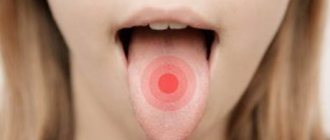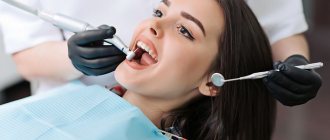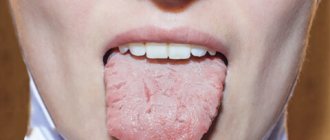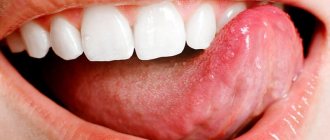Publication date: 01/27/2021
Just as poets consider the eyes to be the mirror of the soul, so doctors are accustomed to viewing the tongue as an organ that reflects the work of the body as a whole. No matter what you complain about, the doctor at the appointment will definitely ask you to stick out your tongue and carefully examine it. And at the dentist’s appointment, special attention will be paid to the tongue. And all because of glossitis. The word is beautiful, but the condition is not. Glossitis is an inflammation of the tongue, one of the signs of which is the appearance of cracks.
Tongue in cracks - reasons
- Bacterial and viral infections
This doesn't just apply to infections in the mouth. Viruses and bacteria spread throughout the body, and the infection manifests itself in the tongue. Most often, cracks in the tongue are caused by the herpes virus. - Anemia
Iron deficiency can cause glossitis. Iron is transported by a special protein - myoglobin, which is responsible for the healthy state of muscle tissue. If there is not enough iron, all muscles suffer, including the tongue. - Allergic reaction
The body's response to various allergens: food, medications, sometimes even toothpaste components - can cause inflammation. - Mouth injuries
Burns, cuts, and any mechanical injuries become an environment where bacteria multiply, which means inflammation occurs. - Vitamin deficiency
It has been scientifically proven that a deficiency of B vitamins can lead to cracked tongue.
Speech development disorders in children and their correction
Speech formation is one of the main characteristics of a child’s overall development. Normally developing children have good abilities to master their native language. Speech becomes an important means of communication between the child and the world around him, the most perfect form of communication inherent only to humans. But since speech is a special higher mental function provided by the brain, any deviations in its development should be noticed in time. For normal speech formation, it is necessary that the cerebral cortex reaches a certain maturity, the articulatory apparatus is formed, and hearing is preserved. Another indispensable condition is a complete speech environment from the first days of a child’s life. The main indicators of speech development from 1 year to 6 years are given in Table 1.
Speech is one of the complex higher mental functions and has two important components:
- perception of speech sounds, for which Wernicke's center is responsible (located in the auditory cortex of the temporal lobe);
- reproduction of sounds, words, phrases is a speech motor function, which is provided by Broca's center (located in the lower parts of the frontal lobe, in close proximity to the projection in the cortex of the muscles involved in speech).
Both speech centers in right-handers are located in the left hemisphere of the brain (Fig. 1), and in left-handers, on the contrary, in the right. In accordance with this, a distinction is made between impressive speech (the process of listening to speech, understanding the meaning and content of a speech utterance) and expressive speech (the process of speaking using language).
| Figure 1. Speech centers of the brain |
During speech development, children must master several subsystems of their native language. The first of these is phonetics, the system of speech sounds. Any language is based on a certain signal or phonemic feature, changing which changes the meaning of the word. This signal, semantically distinctive feature forms the basis of the sound units of language - phonemes (from the Greek phonema - “speech sound”). There are 42 phonemes in the Russian language, including 6 vowels and 36 consonants. The main semantic distinctive features include sonority and dullness (was-dust, house-volume, guest-bone), hardness and softness (dust-dust), stressed and unstressed (za'mok-zamo'k).
In addition, language is an ordered system in which all parts of speech are interconnected according to certain rules. The set of these rules makes up grammar, thanks to which words are formed into complete semantic units. Syntax sets the rules for combining words in a sentence, semantics explains the meaning of individual words and phrases, and pragmatics sets the social rules that dictate what, how, when, and to whom to speak. In the process of speech development, children master these laws of their native language (J. Butterworth, M. Harris, 2000).
The reasons for the delay in speech development may be pathology during pregnancy and childbirth, dysfunction of the articulatory apparatus, damage to the organ of hearing, a general lag in the mental development of the child, the influence of heredity and unfavorable social factors (insufficient communication and education). Difficulties in mastering speech are also typical for children with signs of retarded physical development, those who suffered serious illnesses at an early age, those who are weakened, or those who receive malnutrition.
Hearing impairment is a common cause of isolated speech delay. It is known that even moderately pronounced and gradually developing hearing loss can lead to delays in speech development. Signs of hearing loss in a baby include a lack of response to sound signals and an inability to imitate sounds, while in an older child there is excessive use of gestures and close observation of the movements of the lips of speaking people. However, the assessment of hearing based on the study of behavioral reactions is insufficient and is subjective. Therefore, if partial or complete hearing loss is suspected, a child with isolated speech delay should undergo an audiological examination. The method of recording auditory evoked potentials also provides reliable results. The sooner hearing defects are detected, the sooner it will be possible to begin appropriate corrective work with the baby or equip him with a hearing aid.
Less commonly, a delay in speech development is associated with a child having autism or a general mental retardation. In such cases, an in-depth psychoneurological examination is indicated.
Classifications of speech development disorders in children
Diagnosis of speech development disorders requires the participation of not only doctors, but also speech therapists, psychologists, and special education specialists in helping the child. To date, no unified classification of speech disorders in children has been developed. Depending on the leading disorders underlying speech disorders in children, L. O. Badalyan (1986, 2000) proposed the classification below.
I. Speech disorders associated with organic damage to the central nervous system (CNS). Depending on the level of damage to the speech system, they are divided into the following forms.
- Aphasia is the collapse of all components of speech as a result of damage to the cortical speech areas.
- Alalia is a systemic underdevelopment of speech as a result of damage to the cortical speech zones in the pre-speech period.
- Dysarthria is a violation of the sound pronunciation side of speech as a result of a violation of the innervation of the speech muscles. Depending on the location of the lesion, several variants of dysarthria are distinguished: pseudobulbar, bulbar, subcortical, cerebellar.
II. Speech disorders associated with functional changes in the central nervous system (stuttering, mutism and surdomutism).
III. Speech disorders associated with defects in the structure of the articulatory apparatus (mechanical dyslalia, rhinolalia).
IV. Delays in speech development of various origins (prematurity, severe diseases of internal organs, pedagogical neglect, etc.).
In domestic speech therapy, two classifications of speech disorders are used: clinical-pedagogical and psychological-pedagogical (L. S. Volkova, S. N. Shakhovskaya et al., 1999). These classifications, although they consider the same phenomena from different points of view, do not contradict, but complement one another and are focused on solving different problems of a single, but multifaceted process of correction of speech development disorders. It should be noted that both classifications relate to primary speech underdevelopment in children, i.e. to those cases when speech development disorders are observed with intact hearing and normal intelligence.
The clinical and pedagogical classification is based on the principle “from general to specific”, focused on detailing the types and forms of speech disorders, developing a differentiated approach to overcoming them (L. S. Volkova, S. N. Shakhovskaya et al., 1999). Disorders of the development of oral speech are divided into two types: phonation (external) design of the utterance, which are called disorders of the pronunciation side of speech, and structural-semantic (internal) design of the utterance.
Violations of phonation registration of utterances include:
- Dysphonia (aphonia) is a disorder (or absence) of phonation due to pathological changes in the vocal apparatus; Dysphonia manifests itself in disturbances in the strength, pitch and timbre of the voice.
- Bradylalia is a pathologically slow rate of speech, manifested in the slow implementation of the articulatory speech program.
- Tahilalia is a pathologically accelerated rate of speech, manifested in the accelerated implementation of the articulatory speech program.
- Stuttering is a violation of the tempo-rhythmic organization of speech, caused by the convulsive state of the muscles of the speech apparatus.
- Dyslalia is a violation of sound pronunciation with normal hearing and intact innervation of the speech apparatus (synonyms: sound pronunciation defects, phonetic defects, phoneme pronunciation defects).
In the psycholinguistic aspect, pronunciation disorders can arise due to three main reasons: deficiencies in the operations of discrimination and recognition of phonemes (perception defects); unformed operations of selection and implementation of pronounced sounds; violation of the conditions for the realization of sounds in case of anatomical defects of the speech apparatus.
In most children, sound pronunciation reaches the language norm by 4–5 years. Most often, speech defects are caused by the fact that the child’s articulatory base has not been fully formed (the entire set of articulatory positions necessary to pronounce sounds has not been mastered) or the articulatory positions have not been formed correctly, as a result of which distorted sounds are produced.
- Rhinolalia is a violation of voice timbre and sound pronunciation caused by anatomical and physiological defects of the speech apparatus. With rhinolalia, distorted pronunciation of all speech sounds is observed, and not individual ones, as with dyslalia.
- Dysarthria is a violation of the sound pronunciation side of speech, caused by organic damage to the central nervous system and disorders of the innervation of the speech apparatus.
Violations of the structural-semantic (internal) design of a statement include two subtypes.
- Alalia is the absence or underdevelopment of speech due to damage to the speech areas of the cerebral cortex in the prenatal or early (pre-speech) period of a child’s development (synonyms: dysphasia, early childhood aphasia, developmental dysphasia).
- Aphasia is a complete or partial loss of speech caused by local lesions of the speech areas of the cerebral cortex (as a result of traumatic brain injury, cerebrovascular accidents, neuroinfections and other diseases accompanied by damage to the central nervous system).
The psychological and pedagogical classification (L. S. Volkova, S. N. Shakhovskaya et al., 1999) is built on the opposite principle - “from the particular to the general.” This approach is focused on speech therapy intervention as a pedagogical process, the development of speech therapy correction methods for working with a group of children (study group, class). For this purpose, the general manifestations of various forms of speech disorders are determined. In accordance with this classification, speech disorders are divided into two groups: impairment of means of communication and impairments in the use of means of communication. Communication disorders include phonetic-phonemic underdevelopment and general speech underdevelopment (GSD).
Phonetic-phonemic underdevelopment of speech is a violation of the processes of formation of the pronunciation system of the native language in children with various speech disorders due to defects in the perception and pronunciation of phonemes. The following main manifestations of this condition are identified (T. B. Filicheva et al., 1989).
- Undifferentiated pronunciation of pairs or groups of sounds. In these cases, the same sound can serve as a substitute for two or even three other sounds for the child. For example, the soft sound t' is pronounced instead of the sounds s', ch, sh: “tyumka” (bag), “tyaska” (cup), “hoe” (hat).
- Replacing some sounds with others. Sounds that are difficult to pronounce are replaced by easier ones, which are characteristic of the early period of speech development. For example, the sound l is used instead of the sound r , the sound f - instead of w . In some children, a whole group of whistling and hissing sounds can be replaced by the sounds t and d : “tobacco” (dog).
- Mixing sounds. This phenomenon is characterized by the unstable use of a number of sounds in different words. A child can use sounds correctly in some words, but in others, replace them with similar ones in articulation or acoustic characteristics. So, a child, able to pronounce the sounds r , l or s in isolation, in speech utterances says, for example: “The carpenter is planing a board” instead of “The carpenter is planing a board.”
Such violations indicate underdevelopment of phonemic hearing (the ability to distinguish phonemes), which is confirmed during the examination. Underdevelopment of phonemic hearing prevents the full implementation of sound analysis of words. That is why, by school age, this group of children has insufficient prerequisites for learning to write and read.
OSD includes various complex speech disorders, in which the formation of all components of the speech system related to the sound and semantic side suffers. By OHP we understand the impaired formation of all components of the speech system in their unity (sound structure, phonemic processes, vocabulary, grammatical structure, semantic aspects of speech) in children with normal hearing and initially preserved intelligence.
OHP is heterogeneous in its developmental mechanisms and can be observed in various forms of oral speech disorders (alalia, dysarthria, etc.). Common signs include a late onset of speech development, a poor vocabulary, agrammatisms, pronunciation defects, and phoneme formation defects. Underdevelopment can be expressed to varying degrees: from the absence of speech or its babbling state to extensive speech, but with elements of phonetic and lexico-grammatical underdevelopment. Depending on the degree of impairment in the formation of means of communication, ONR is divided into three levels. According to R. E. Levina (1968), these levels of speech underdevelopment are designated as:
- lack of common speech (so-called “speechless children”);
- the beginnings of common speech;
- developed speech with elements of underdevelopment in the entire speech system.
Thus, the development of ideas about OSD in children is focused on the development of correction methods for groups of children with similar manifestations of various forms of speech disorders. It is necessary to take into account that ONR can be observed with various lesions of the central nervous system and deviations in the structure and functions of the articulatory apparatus (R. E. Levina, 1968; L. S. Volkova, S. N. Shakhovskaya et al., 1999), i.e. e. for various clinical forms of oral speech disorders. The concept of ONR reflects the close relationship of all components of speech during its abnormal development, but at the same time emphasizes the possibility of overcoming this lag and moving to qualitatively higher levels of speech development.
However, the primary mechanisms of ANR cannot be elucidated without a neurological examination, one of the important tasks of which is to determine the location of the lesion in the nervous system, i.e., making a topical diagnosis. At the same time, diagnostics is aimed at identifying the main disrupted links in the development and implementation of speech processes, on the basis of which the form of speech disorders is determined. There is no doubt that when using the clinical classification of speech development disorders in children, a significant proportion of cases of OHP turn out to be associated with alalia. At the same time, damage to various zones of the cerebral cortex in the pre-speech period entails a certain originality in the formation of alalia symptoms.
Alalia is one of the most severe speech development disorders. Alalia is a systemic underdevelopment of speech of central origin. The insufficient level of development of the speech centers of the cerebral cortex, which underlies alalia, can be congenital or acquired in the early stages of ontogenesis, in the pre-speech period. The cause of alalia may be early organic damage to the central nervous system due to the pathology of pregnancy and childbirth. In recent years, special attention of researchers has been drawn to the role of hereditary factors in the formation of both speech abilities and various speech development disorders, including alalia.
Complete or partial loss of speech caused by local lesions of the speech areas of the cerebral cortex is called aphasia. Aphasia is the decay of already formed speech functions, so this diagnosis is given only to children over 3–4 years old. With aphasia, there is a complete or partial loss of the ability to understand spoken speech or speak, that is, to use words and phrases to express one’s thoughts. Aphasia is caused by damage to the speech centers in the cortex of the dominant hemisphere (for right-handers - left, for left-handers - right) in the absence of disturbances in the articulatory apparatus and hearing.
In cases of lesions of the speech centers in children under the age of 3–4 years, speech usually develops, but with a pronounced lag. Domestic experts refer to this condition as alalia. The international term “dysphasia” or “developmental dysphasia” is more accurate. Similar to aphasia in adults, motor and sensory alalia (dysphasia) are distinguished.
Motor alalia (dysphasia) is a systemic underdevelopment of expressive speech of central origin. The child has disturbances in articulatory praxis and the organization of speech movements, therefore speech development is delayed. There is a search for articulation, an inability to perform certain articulatory movements and their sequences. The child cannot find the correct sequence of sounds in a word, words in a phrase, and cannot switch from one word to another. This leads to an abundance of errors, permutations, and perseverations in speech (multiple repetition of the same syllable or word). As a result, in a child with motor alalia, with good hearing and sufficient understanding of speech, in the absence of paresis of the articulatory muscles, independent speech does not develop for a long time, or it remains at the level of individual sounds and words.
Already at an early age, attention is drawn to the absence or limitation of babbling. Parents note silence, emphasize that the child understands everything, but does not want to speak. Instead of speech, facial expressions and gestures develop, which children use selectively in emotionally charged situations.
The first words and phrases appear late. Parents note that, in addition to speech delays, in general, children develop normally. As their vocabulary increases, the difficulties children have in mastering word structure become more noticeable. Speech is slow. There are many slips of speech in the speech stream, which children pay attention to and try to correct what was said incorrectly - especially as they develop. Examples of word distortions: button - “kubyka”, “puzyka”, “puzuvisa”, “kubiska”; February - “Fral”, “Viral”, “Faral”.
Vocabulary is formed slowly, distorted, and incorrect use of words is common. Substitutions of words based on external signs of an object or action are typical: washes-washes, ax-hammer, cup-glass, etc. Children do not know how to use synonyms, antonyms, and generalizing words. The stock of adjectives and adverbs is narrow and monotonous.
The vocabulary is poor, limited to everyday topics. The child cannot explain the meaning of words and does not know how to use word formation. In their statements, children find it difficult to coordinate words, use gender and numerical endings, and do not use prepositions and conjunctions. Their phrases consist of unchangeable words (“Book, Tanya!” and a gesture of request), which makes them understandable only in a certain situation. The number and order of words in the sentences are disturbed; the child responds with one or two words (mainly nominative sentences-nouns in the correct or distorted case version) in combination with a gesture. In case of alalia, the lack of formation of the sentence structure is a consequence of the immaturity of internal speech operations - choosing a word and constructing a plan of utterance.
There is a systematic underdevelopment of all aspects and functions of speech. There are difficulties in constructing phrases, mastering grammatical structure, insufficient development of imitative activity (including imitative speech) and all forms of voluntary speech. Children are not able to gradually transfer familiar words from a passive to an active vocabulary.
With little speech activity, the child’s general cognitive activity suffers. Speech during alalia is not a full-fledged means of communication, organization of behavior and individual development. Intellectual deficiency and a limited supply of knowledge, observed in many children with alalia at different age periods, are therefore secondary in nature.
In some cases, children with alalia develop pathological personality traits and neurotic character traits. As a reaction to speech impairment, they experience isolation, negativism, self-doubt, tension, increased irritability, touchiness, and a tendency to cry. Some children use speech only in emotionally charged situations. The fear of making a mistake and causing ridicule from others leads to the fact that they try to get around speech difficulties, refuse verbal communication, and are more willing to use gestures. Speech disability “excludes” the child from the children’s group and, with age, increasingly traumatizes his psyche.
Sensory alalia (dysphasia) is a systemic underdevelopment of impressive speech of central origin, caused primarily by disturbances in the auditory-speech analyzer. This leads to disorders in the analysis and synthesis of speech signals, as a result of which a connection is not formed between the sound image of a word and the object or action it denotes. The child hears but does not understand the spoken speech.
Sensory alalia is considered a less studied condition than motor alalia. Apparently, this is due to the fact that in its pure form it is much less common; its timely recognition and differential diagnosis can be quite difficult. In particular, it is always necessary to differentiate sensory alalia from hearing loss, which can interfere with normal speech development, as well as autism.
The degree of underdevelopment of the speech-hearing analyzer can be different.
In more severe cases, the child does not understand the speech of others at all, treats it as noise devoid of meaning, does not even react to his own name, and does not distinguish between the sounds of speech and noises of a non-speech nature. He is indifferent to any speech and non-speech stimuli. In other cases, he understands individual words, but loses them against the background of a detailed statement (as happens, for example, in healthy people with insufficient knowledge of a foreign language). When addressing him, the child does not catch all the words and their shades, which results in an incorrect reaction. Phonemic perception develops slowly and remains unformed for a long time. For children with sensory alalia, the situation plays a big role. Often they understand the content of statements only in a certain context and find it difficult to perceive the meaning when changing the forms and order of words, or using grammatical structures.
Often children do not perceive changes in a particular task by ear, and do not distinguish what was said in error from the correct option. Sometimes they ask to repeat the speech addressed to them and understand only what is spoken several times. Some children only understand what they can say themselves. Such pronunciation helps to improve understanding.
Children often look at the speaker's face. In this case, speech understanding improves due to the reinforcement of the auditory impression from the visual analyzer - “reading from the face” occurs. Sometimes a child understands only a certain person - a mother, a teacher - and does not understand when someone else says the same thing.
Children with sensory alalia can spontaneously repeat individual syllables, sound combinations, words and short phrases they hear, although this repetition is unstable. Imitation of speech sounds with sensory alalia is not constant and largely depends on the situation. Children are not able to form connections between an object and its name; they do not form a correspondence between the words they hear and the words they pronounce. The child's understanding of the meanings of the words he pronounces is unstable. His active vocabulary exceeds his passive one.
When pronouncing words, the child is not confident in the correctness of his own speech and looks for adequate speech movements, for example: elephant - “sleep”, “vylon”, “sylon”, “salon”. Errors in speech are qualitatively different than with motor alalia. On the one hand, diffuse undifferentiated perception of sounds leads to their incorrect pronunciation, and on the other hand, errors lead to numerous searches for the necessary kinesthesia.
Sometimes there is an incoherent reproduction of all the words known to the child - a kind of logorrhea; perseverations are noted with repetitions of a heard or spoken word or phrase (echolalia), while the words are not comprehended and not remembered.
The words contain numerous errors in stress, sound substitutions, and distortions, and with each new repetition the nature of the distortions and substitutions usually changes. The child learns new words and phrases slowly. The child's statements are imprecise and may be difficult to understand. He is not critical of his own speech. Distortions in expressive speech are caused by the inferiority of perception of one’s own speech and the speech of others.
Due to the instability of understanding the meanings of words, children, having received verbal instructions, act uncertainly, seek help, have limited opportunities for organizing role-playing games, and cannot listen for a long time when they are read or told.
In less severe forms of sensory alalia, when children have formed their own speech, they speak easily, without tension, do not think about the choice of words, the accuracy of the statement, the construction of the phrase, and do not notice the mistakes made. Children do not control their own speech; they use words and phrases that are not related to the situation and are devoid of meaning. Speech is fragmentary. Because the child's statements are inaccurate in content and erroneous in form, it is often difficult for others to understand what he is talking about. In spoken words there are many sound substitutions, omissions, perseverations, connections of parts of words with each other (contamination). In general, the speech of a child with sensory alalia can be characterized as increased speech activity against the background of impaired understanding of the speech of others and insufficient control over one’s own speech.
Sensory alalia in its pure form is relatively rare; much more often sensory deficiency accompanies motor alalia. In these cases we speak of motor alalia with a sensory component or sensorimotor alalia. The existence of mixed forms of alalia indicates the functional continuity of the speech-motor and speech-auditory analyzers. A thorough examination of a child with alalia makes it possible to clarify the nature of the disorders, establish the leading inferiority in the structure of speech disorders and determine the optimal approaches to their correction.
Treatment of speech development disorders in children
In order for assistance to a child with a delay in speech development to be effective, an integrated approach and coordinated work of different specialists (doctors, speech therapists, psychologists, teachers), as well as the active participation of parents, are necessary. It is important that these joint efforts are aimed at early detection and timely correction of speech disorders in children. The main areas of correctional work for speech development disorders in children are: speech therapy work, psychological and pedagogical correctional measures, psychotherapeutic assistance to the child and his family, as well as drug treatment.
Since alalia represents the most complex medical, psychological and pedagogical problem, the complexity of the impact and continuity of work with children by specialists of various profiles are of particular importance when organizing assistance to such children. Speech therapy and psychological-pedagogical correctional measures should be carried out over a long period of time and systematically. In the process of speech development in children with alalia, certain positive dynamics can be traced; they consistently move from one level of speech development to another, higher one. They acquire new speech skills and abilities, but often remain children with underdeveloped speech. During schooling, children experience difficulties in mastering written language skills. Therefore, along with speech therapy and psychological and pedagogical correction, children with alalia are recommended to be prescribed repeated courses of therapy with nootropic drugs.
Nootropics are a group of drugs that differ in their composition and mechanisms of action, but have a number of common properties: they have a positive effect on the higher integrative functions of the brain, improve memory, facilitate learning processes, stimulate intellectual activity, increase the brain’s resistance to damaging factors, improve cortical-subcortical connections.
| Figure 2. Changes in the vocabulary of children with motor alalia in the control and main (encephabol treatment) groups over 2 months |
Treatment of alalia is a long process, during which there is a need for repeated therapeutic courses with nootropic drugs, for example, encephabol (Fig. 2) or others (Table 2). The repeated prescription of nootropics is also due to the fact that in addition to speech disorders, many children with alalia have to overcome concomitant cognitive, motor and behavioral disorders. It is advisable to prescribe nootropic drugs in the form of monotherapy, while paying attention to the individual selection of optimal dosages and duration of treatment. In the first days of use, a gradual increase in dose is recommended. The duration of treatment courses ranges from 1 to 3 months. Most nootropic drugs are prescribed in the first half of the day.
Side effects during treatment with nootropic drugs in children are rare, they are unstable and insignificantly expressed. They often occur due to insufficiently strict parental control and inaccurate adherence to the medication regimen (taking into account a gradual increase in dose) and administration in the morning and afternoon. Possible side effects of drug therapy with nootropic drugs include: increased emotional lability, irritability, difficulty falling asleep and restless sleep. If such complaints appear, clarifications should be made to the drug prescription regimen and the dose should be slightly reduced.
In conclusion, we should once again emphasize the need for early detection, timely and comprehensive diagnosis and correction of speech development disorders in children, combining the efforts of doctors, speech therapists, teachers and psychologists.
Literature
- Badalyan L. O. Neuropathology. M.: Academy, 2000. 382 p.
- Butterworth J., Harris M. Principles of developmental psychology: trans. from English M.: Cogito-Center, 2000. 350 p.
- Volkova L. S., Shakhovskaya S. N. Speech therapy. 3rd ed. M.: Vlados, 1999. 678 p.
- Levina R. E. Fundamentals of the theory and practice of speech therapy. M.: Education, 1968. 367 p.
- Filicheva T. B., Cheveleva N. A., Chirkina G. V. Fundamentals of speech therapy. M.: Education, 1989. 221 p.
N. N. Zavadenko, Doctor of Medical Sciences, Professor of Russian State Medical University, Moscow
Symptoms
Inflammation manifests itself in different ways, depending on the individual characteristics of the person and the underlying cause of the disease. Common symptoms include:
- Unpleasant sensations in the mouth
- Color change
- Pain
- Edema
- Burning or itching
- Surface change
- Changes in the size and shape of the papillae
- Cracks
- Difficulty swallowing
- Chewing problems
- Gray plaque
- Difficulty speaking
Desquamative
Glossitis on the tongue, as in the photo, is scientifically called desquamative, migratory or exfoliative1, but popularly this disease is better known as “geographic tongue”, because in appearance it resembles a geographical map with clearly defined continents in the form of bright red areas of the affected area. mucous membrane.
The photo shows the geographic language
The disease most often develops in the fair half of humanity, more often during pregnancy due to metabolic disorders, when the expectant mother lacks vitamins and useful nutritional minerals. Also, pathology often develops against the background of chronic lesions of the gastrointestinal tract, burns of the mucous membrane and acute allergic reactions.
It is worth knowing that this form rarely develops into an acute stage, so if characteristic signs appear, you should not wait for accompanying symptoms, such as pain or swelling - you should immediately consult a doctor.
Online consultation with a doctor if you are concerned about symptoms
If you are concerned about cracks in the tongue and the symptoms listed in the article: discoloration, swelling, pain, burning, difficulty swallowing and speaking due to an enlarged tongue, consult a doctor. To identify a disease with similar symptoms, in most cases, a visual examination is sufficient. An online consultation with a dentist will help you timely recognize the degree of soft tissue damage, the exact location and the appropriate treatment regimen. If you do not pay attention to cracks in the tongue, you may not notice more serious diseases and complications from them: abscesses, phlegmons. Treatment in this case will be long and more expensive.
Complications
The development of desquamative glossitis should not be ignored, and if detected, you should seek the help of a specialist. Many patients, having discovered a similar pathology in themselves, mistakenly take it for a cancerous tumor, although in fact the geographical language has nothing in common with it.
This benign disease does not have a tendency to become malignant; it is treated by a dentist and a gastroenterologist; in serious cases, an examination by a hematologist, gastroenterologist and endocrinologist is required.
If therapeutic measures to eliminate the geographic tongue are not carried out in a timely manner, the disease takes on a more advanced form with relapses and will be more difficult to treat. In addition, there is a risk of swelling of the tongue, which adversely affects breathing; chewing and swallowing functions are also affected. Next, the process involves regional tissues and organs.
Treatment in the clinic
Before prescribing medications and procedures, it is necessary to find out why cracks occur. After this, a plan is drawn up, which may include:
- Treatment of a common disease
- Antifungal medications
- Iron tablets
- Vitamins
- Corticosteroids
- Immunostimulants
- Antihistamines
The surface of the tongue is disinfected with antiseptic solutions. Painkillers are used to reduce pain.
If mechanical injuries occur as a result of unsuccessful prosthetics, it is recommended to replace the structure.
Atrophic or pellagritic form
With this pathology, the inflamed tongue, as in the photo, does not significantly change its natural color, but it becomes very smooth, which is why it is easily confused with the Gunter variety. However, here the atrophy of the papillae is more pronounced; if left untreated, they decrease and may even completely disappear from the mucous membrane. In rare cases, a decrease in the muscle organ itself occurs.
The atrophic form is characterized by smoothness of the tongue
The disease is caused by an acute lack of vitamins in the body, as well as a lack of nicotinic acid.
Home Remedies
Folk remedies are not able to eliminate the cause of cracks, especially if it is a common disease. In rare cases, the body can defeat a bacterial infection on its own. Therefore, medications from a home medicine cabinet can only be considered auxiliary. These include:
- Gargling with decoctions of sage and chamomile
- Lotions with sea buckthorn or olive oil
- Propolis
- Potato juice applications
Incorrectly selected folk remedies can reduce the effect of drug treatment.
Be sure to consult your doctor.
Folded shape
The name speaks for itself. This form of glossitis has the following visual symptoms: folds, grooves, the presence of longitudinal and transverse lines. It is interesting that most patients seek help and undergo treatment only because of complaints of a visual defect and an unusual appearance of the tongue, because The pathology practically does not manifest itself with other signs.
The photo shows a folded tongue
Despite the absence of pain and discomfort, the folded form of the disease must be treated, because grooves and folds are an excellent place for the accumulation of pathogenic bacteria and tiny food particles, and thorough hygiene of these areas is almost impossible. Due to lack of treatment, the patient may develop serious inflammatory processes in the oral cavity and abscesses, the removal of which will require surgery and long-term drug therapy.
Be sure to read the whole truth about the folded tongue and the reasons for its appearance in the feature article on the website.
Top five dental clinics
All clinics on the list are multidisciplinary. They are engaged in prevention, treatment, prosthetics and implantation.
| Dental center | Clinic address | General information |
| Cerecon | Moscow, Andropova Ave. 8 | Metro Technopark. Opening hours: 24 hours a day |
| ROOT | Moscow, st. Rustaveli, 14 building 9 | Metro Butyrskaya. Opening hours from 10:00 to 22:00 |
| Alpha-Dent | Moscow, Beskudnikovsky blvd., 24, bldg. 1 | Metro Petrovskoye-Razumovskoye. Open all days of the week. |
| MegaStom | Moscow, Bolshoi Kozlovsky lane, building 10, building 2 | Metro Red Gate. They don't work on Sundays |
| Denta amo | Moscow, st. Grekova, 9 | Metro Medvedkovo Open daily from 9 to 9. |
Congenital pathologies of the tongue and frenulum - types and features
Anomalies of the tongue can be either congenital or acquired; they are often the result of certain pathological processes occurring in the body. Currently, malformations of the main speaking organ are quite rare. Many of them are serious problems that often require surgery. Further in this article we will talk about what congenital defects of the tongue and frenulum exist, how they are corrected, and also consider in detail such a pathology as a folded tongue.
Congenital pathology of the frenulum
Separately, it is worth highlighting the independent pathology of the frenulum of the tongue - the part attached to its center from below. There are also frenulums of the upper and lower lips - they join the mucous membrane in the area of the central incisors. In normal development, the hyoid ends right in the center of the organ, while in a disorder called ankyglossia, it is located too close to its tip - this anatomical abnormality is often called a short frenulum.
Congenital pathology of the frenulum of the tongue
On a note! Today, cases of ankyglossia occur in one child out of a thousand. Moreover, this pathology is diagnosed almost three times more often in boys than in girls1.
With this pathology, at the stage of breastfeeding, the baby is unable to latch onto the breast normally. Later, the child will experience certain difficulties in speech, will not be able to pronounce individual sounds and stick out his tongue far. Often there are disturbances in the formation of the dental system as a whole, and displacement of teeth is observed due to improper functioning of the tongue.
“I remember when I was a child my bridle was cut. True, I can’t say that I experienced any serious difficulties while talking or eating. It’s just that at the next examination at the dentist, he said that it was better to trim it so that the jaw would continue to form correctly, it seems like that. In general, the procedure was simple, there was generally no pain..."
Arthur H., Tolyatti, from correspondence on a thematic forum
Today, if this anomaly is detected, it can be corrected in the maternity hospital. At this age, the frenulotomy procedure is absolutely painless and does not require anesthesia, since there are no nerve endings in these tissues. In other cases, the operation is performed in preschool or school age as prescribed by a dentist. There is also an option for the so-called frenulum stretching - a speech therapist works with the problem. However, you should contact this doctor in any case if the frenulum is cut after the child has already learned to speak, because a new pronunciation will be required, taking into account the correct position of the tongue.










